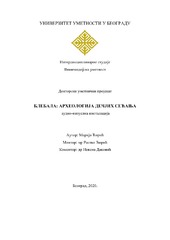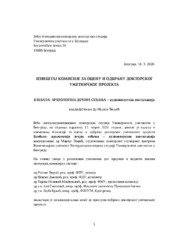| dc.contributor.advisor | Ћирић, Растко | |
| dc.contributor.other | Поповић Млађеновић, Тијана | |
| dc.contributor.other | Гњатовић, Ана | |
| dc.contributor.other | Бркић, Љуба | |
| dc.creator | Ћирић, Марија | |
| dc.date.accessioned | 2020-03-20T09:54:01Z | |
| dc.date.available | 2020-03-20T09:54:01Z | |
| dc.date.issued | 2020-07-03 | |
| dc.date.submitted | 2020-03-20 | |
| dc.identifier.uri | http://eteze.arts.bg.ac.rs/handle/123456789/453 | |
| dc.description.abstract | Блебала: археологија дечјих сећања бави се темом дечјих сећања,
конкретизованом у форми аудио-визуелне инсталације. Реч је о погледу на детињство из
визуре одрасле особе (која сањари и игра се), са циљем проналаска стваралачког
надахнућа. Први сегмент наслова пројекта је позајмљен. „Блебала“ (“Jabberwocky”) је
строфична песмица, текст који ме опседа од детињства. Део је књиге Алиса у земљи иза
огледала (Through the looking glass) Луиса Керола (Lewis Carroll), која ми је увек била
привлачнија од оне у земљи чуда. Можда баш због „Блебале“ и препева Луке
Семеновића. „Археологија“, опет, претпоставља призивање слика једне сањарије која
реимагинира детињство, која изнова чини бивствујућим његове могућности, која може
да унесе динамизам животне лепоте неупоредиво више него у реалном постојању.
Обраћајући се дечјим сећањима, не желим да код читаоца/ гледаоца/ слушаоца створим
призоре старинарнице личних успомена. Вишемедијско дело Блебала: археологија
дечјих сећања конципирано је као вид спонтаног изражавања, мишљено је на начин како
би то, присећам се, учинило дете. Обухвата уметности/ медије филма, музике,
радиофоније, књижевности (на известан начин. чак и ликовне уметности и архитектуре);
подразумева укључивање чула вида и слуха (посредно и додира и укуса), комуницира
путем више врста знакова (визуелни: покретне слике, цртеж; аудитивни: музички,
вербални, шумови/ звучни ефекти; кинестетички); конципирана је кроз тространу
визуелну структуру обједињену звуком. Теоријски текст, као пратећи елемент
уметничког пројекта, усредсређен је на оквире настанка дела (поетичке/ стваралачке,
теоријске, методске, техничко-технолошке...): по указивању на поетичке импулсе
(„кратке сусрете“ са одабраним опусима), изложила сам сегменте сопственог
уметничког деловања који функционишу у смислу „предшколе“ докторског уметничког
пројекта. Текст је заокружен експликацијом стваралачких разлога и поступака
докторског уметничког пројекта, односно, књигом снимања (централног елемента)
аудио-визуелне инсталације Блебала: археологија дечјих сећања. | en |
| dc.description.abstract | Blebala: The Archaeology of Childhood Memories explores the theme of childhood
memories, concretized in the form of an audio-visual installation. It offers a view of childhood
from the perspective of an adult (who is daydreaming and playing) with the aim of finding
creative inspiration. The first part of the project's title is borrowed. “Blebala” /”Jabberwocky”/
is a stanza poem, the verses that have obsessed me since childhood. The poem comes from
Through the Looking Glass, a novel by Lewis Carroll, which I have always found more
appealing than its predecessor – Alice in Wonderland, perhaps precisely because of
“Jabberwocky”'s translation by Luka Semenović. “Archaeology”, again, implies the evocation
of images of a reverie that re-imagines childhood, re-enacts its possibilities and strives to
inspire the beauty of living, to a considerably higher extent than in real life. By turning to
childhood memories, I do not intend to introduce the reader/ spectator/ listener to an antique
shop of my personal memories. Blebala: The Archaeology of Childhood Memories is a
polymedia work, conceived as a form of spontaneous expression, and is designed in a way that,
as I recall, a child would employ. It brings together various forms of art/ media – film, music,
radiophony, literature (and, in some ways, even fine arts and architecture); it engages the senses
of sight and hearing (and indirectly the senses of touch and taste), it communicates through
several types of signs (visual: motion pictures, drawings; auditory: musical, verbal, noise/
sound effects; and kinaesthetic). The project is designed as a three-fold visual structure united
by a sound. The paper accompanying the artistic project focuses on the framework and the
background of the work (poetic/ creative, theoretical, methodological, technical and
technological). After explaining the poetic impulses (“brief encounters” with selected oeuvres),
I set out the segments of my own artistic engagement, which operates as a “pre-school” for this
doctoral artistic project. The text concludes with an explanation of the creative reasons and
procedures underpinning the project, providing the recording book (of the central part) of the
audio-visual installation Blebala: The Archaeology of Childhood Memories. | en |
| dc.language.iso | sc | en |
| dc.publisher | Универзитет уметности у Београду, Интердисциплинарне студије Универзитета уметности | sr |
| dc.source | Интердисциплинарне студије Универзитета уметности | sr |
| dc.title | БЛЕБАЛА: АРХЕОЛОГИЈА ДЕЧЈИХ СЕЋАЊА – аудиовизуелна инсталација | en |
| dc.type | other | en |
| dcterms.abstract | Ćirić, Rastko; Popović Mlađenović, Tijana; Gnjatović, Ana; Brkić, Ljuba; Ćirić, Marija; BLEBALA: ARHEOLOGIJA DEČJIH SEĆANjA – audiovizuelna instalacija; | |
| dc.contributor.coadvisor | Даковић, Невена | |


